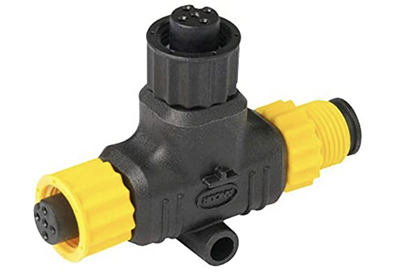Thrusters can make docking easier

…and less embarrassing!
By Andrew McDonald
Corners like it’s on rails. You can almost see it. A car with a low centre of gravity takes a curve. The driver shifts through the gears and exits the bend with speed and grace. Stops on a dime. That same vehicle smoothly downshifts and comes to a complete stop as though hitting an invisible barrier.
Most of our sailing metaphors evoke thoughts and feelings of strong winds pushing a sleek racer faster, or perhaps the crew tacking or gybing around a mark. We don’t seem to have the same colourful expressions to describe the movement of a power or sailing vessel at slow speeds. Poetic statements aren’t being made about pulling away from dock on a misty morning, or tying off when returning at sunset. Shouldn’t there be? The boat moves with, or against the wind. It sneaks into dock like a thief in the night. Turns with the barest touch of the helm. Or perhaps, Spins like she has thrusters.
The advantages of thrusters
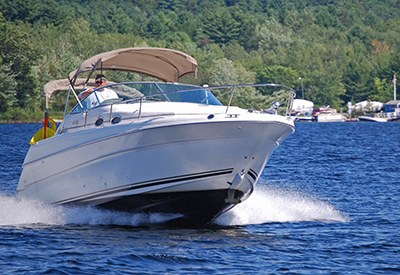 By incorporating bow and stern thrusters, a boat with a single engine can move as easily from side-to-side as fore and aft. A large boat in a crowded slip can be ‘wiggled’ into tight spaces, and maneuverability is possible without touching the wheel. 360-degree spins are possible, as is the ability to move the boat sideways. Systems can be installed in a variety of configurations, and gone are the days of having to buy a boat with a thruster installed by the builder; boat yards are becoming highly adept at aftermarket installations and some DIY projects are well within reach.
By incorporating bow and stern thrusters, a boat with a single engine can move as easily from side-to-side as fore and aft. A large boat in a crowded slip can be ‘wiggled’ into tight spaces, and maneuverability is possible without touching the wheel. 360-degree spins are possible, as is the ability to move the boat sideways. Systems can be installed in a variety of configurations, and gone are the days of having to buy a boat with a thruster installed by the builder; boat yards are becoming highly adept at aftermarket installations and some DIY projects are well within reach.
Note how far forward the unit is mounted, and the lack of holes below the waterline
In the golden days of shipping, port pilots and tugboats were the normal methods of moving large ships into tight docking spaces for loading/unloading. In order to reduce costs, maneuvering thrusters became the norm. Today, what is common amongst large ships has now been popularized aboard pleasure craft.
When most of us imagine a bow or stern thruster aboard a yacht, we have a picture that includes thought-bubbles and dollar signs. The word ‘thrusters’ is equivalent to a higher price. But with the evolution of technology, the inventive ways that thrusters are mounted and used, and with growing competition in the marketplace, is this as true today as it was a decade ago? I would argue that there’s a thruster for everyone.
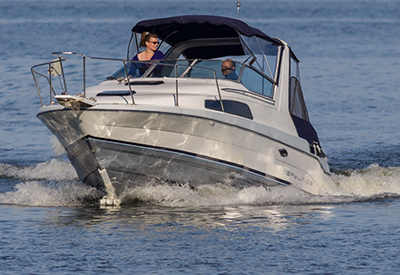 This begs the question: With the obvious advantages of maneuverability and confidence, why doesn’t every boat come equipped with bow and stern thrusters?
This begs the question: With the obvious advantages of maneuverability and confidence, why doesn’t every boat come equipped with bow and stern thrusters?
This Bayliner is proudly sporting an externally-mounted thruster.
When thrusters first became popular aboard yachts, they were designed and installed by the builder. Over time, boat yards became adept at installing thrusters as aftermarket add-ons, drilling a 4-8” hole in the bow or stern below the waterline, fibreglassing in a tunnel with attached electric motor and impeller, and then connecting in the battery, cables, relays and control switches.
For many, this is a daunting DIY task that requires specialized tools and expertise to install well. But, with changes in technology, the sizing and power options are almost as numerous as the installation and mounting methods available.
Some recent innovations mean that a thruster is no longer just a thruster. Each manufacturer has been trying to differentiate themselves with differing designs and features. I spoke with Vetus (one of many thruster manufacturers) about some of the innovations on the market today:
– 48V switching for greater thrust – gone are the days of simple 12V power
– Proportional control – meaning that the speed or force can be controlled, rather than simply switched on and off
– Up to 400mm impeller sizes (15 ¾”) for a wide range of boat sizes and types
– Brushless motors – which prevents overheating and allows the unit to run continuously as long as the battery is sufficient to support the run time
 Beyond some of the innovations in conventional tunnel-style thrusters, there are significant differences in modern design. Jet Thruster has introduced a thruster that utilizes water-jet technology instead of a turning propeller. This design draws water into the unit using a specialized pump and then forces it out under pressure on either port, or starboard sides. The pump can accommodate bow and stern openings (a single, centrally-mounted pump can control jets at both bow and stern). In addition to working on conventional boats, Jet Thrusters can work in unconventional hull types. Trimarans and catamarans can accommodate a jet thruster where a tunnel-style thruster is impractical. Because the Jet Thruster incorporates a resevoir and holds seawater to deliver the thrust, a winterizing component is necessary that isn’t needed in tunnel-style thrusters.
Beyond some of the innovations in conventional tunnel-style thrusters, there are significant differences in modern design. Jet Thruster has introduced a thruster that utilizes water-jet technology instead of a turning propeller. This design draws water into the unit using a specialized pump and then forces it out under pressure on either port, or starboard sides. The pump can accommodate bow and stern openings (a single, centrally-mounted pump can control jets at both bow and stern). In addition to working on conventional boats, Jet Thrusters can work in unconventional hull types. Trimarans and catamarans can accommodate a jet thruster where a tunnel-style thruster is impractical. Because the Jet Thruster incorporates a resevoir and holds seawater to deliver the thrust, a winterizing component is necessary that isn’t needed in tunnel-style thrusters.
A Canadian company called Sideshift has created a thruster that is much more practical for the do-it-yourselfer. Their units are externally mounted, with no holes in the hull below the waterline. A single 3/8” hole is drilled to accommodate wiring, located above the waterline. Their niche has been in direct sales to consumers; kits including everything needed for installation (including caulking and thread locker), with the exception of a battery and main battery cable. They’ve also developed a reliable wireless helm remote, which avoids the difficulty of running added cabling from the unit to the helm. Sideshift has also developed a retractable unit that is designed to be mounted to the underside deck of pontoon boats – a hull style that isn’t compatible with more traditional thrusters. Sideshift considers their units maintenance-free and they require only annual anode replacement.
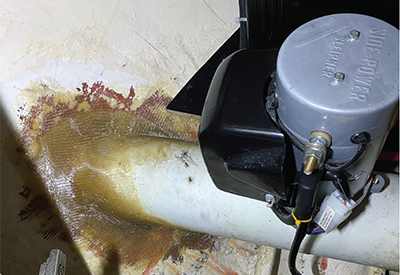 It’s clear that there is indeed a thruster for everyone. The benefits are considerable; maneuverability and confidence are the key standout features. Brand, style, size, power, installation options/cost, and maintenance are the factors to consider when choosing to buy a boat (new or used) with a thruster installed, or when installing an aftermarket unit.
It’s clear that there is indeed a thruster for everyone. The benefits are considerable; maneuverability and confidence are the key standout features. Brand, style, size, power, installation options/cost, and maintenance are the factors to consider when choosing to buy a boat (new or used) with a thruster installed, or when installing an aftermarket unit.
Interior view showing the motor unit on top of a fibreglass tunnel, joined to the vessel’s hull. This unit is located beneath the v-berth on a 34′ cruiser.
Here are a few great resources to check out as you consider thrusters for your boat:
Vetus – how to select, design and build your thruster selection –https://www.youtube.com/watch?v=cAFnq3ejf9w
Jet Thruster – check out this video on both the concept and installation of a jet thruster system – https://www.youtube.com/watch?v=JLDuwnnOCcY -.
Sideshift Thrusters – This is the YouTube page for Sideshift. – https://www.youtube.com/user/sideshift05 –
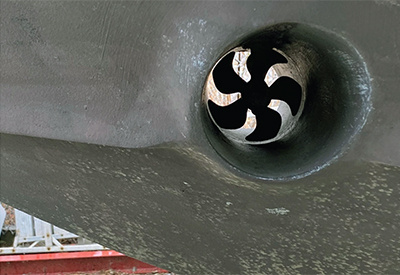 Conclusion
Conclusion
Speak to your dealer or service technician about your boat. The cost may increase the value of your boat significantly and the performance could be an amazing added bonus.
And, watch for more editorial information in upcoming issues of Canadian Yachting where we will explore more about thrusters, DIY projects and related accessories to make docking and boat handling easier and more enjoyable.
Right: Exterior view of a tunnel-style thruster.
Below: the associated wiring: battery, fuse, and on/off switch.





